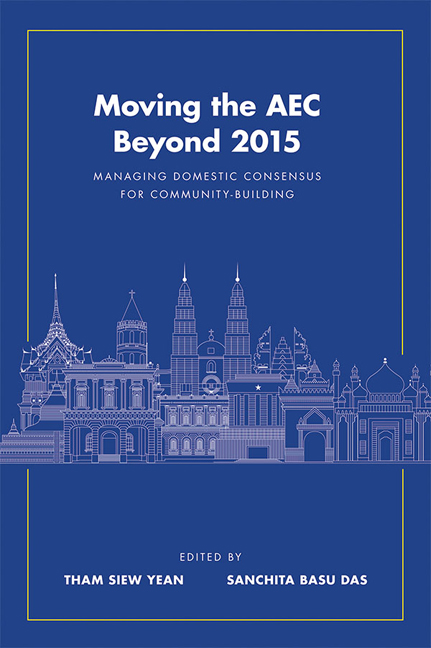Book contents
- Frontmatter
- Contents
- Foreword
- Preface
- Acknowledgements
- Abbreviations
- About the Contributors
- 1 Introduction: Economic Interests and the ASEAN Economic Community
- 2 ASEAN Economic Cooperation and Its Political Realities
- 3 Indonesia's Implementation of Facilitation and Harmonization Measures under the AEC
- 4 The AEC and Domestic Challenges in Malaysia: Examining the Liberalization of Services in AFAS
- 5 The Philippines and the AEC Beyond 2015: Managing Domestic Challenges
- 6 The AEC Beyond 2015: Implementation and Challenges for Singapore
- 7 Moving the AEC Beyond 2015: Managing Domestic Economic Interests in Thailand
- 8 Managing Domestic Consensus for ASEAN Community Building in Vietnam
- Index
7 - Moving the AEC Beyond 2015: Managing Domestic Economic Interests in Thailand
Published online by Cambridge University Press: 06 January 2018
- Frontmatter
- Contents
- Foreword
- Preface
- Acknowledgements
- Abbreviations
- About the Contributors
- 1 Introduction: Economic Interests and the ASEAN Economic Community
- 2 ASEAN Economic Cooperation and Its Political Realities
- 3 Indonesia's Implementation of Facilitation and Harmonization Measures under the AEC
- 4 The AEC and Domestic Challenges in Malaysia: Examining the Liberalization of Services in AFAS
- 5 The Philippines and the AEC Beyond 2015: Managing Domestic Challenges
- 6 The AEC Beyond 2015: Implementation and Challenges for Singapore
- 7 Moving the AEC Beyond 2015: Managing Domestic Economic Interests in Thailand
- 8 Managing Domestic Consensus for ASEAN Community Building in Vietnam
- Index
Summary
INTRODUCTION
ASEAN achieved a milestone with the launch of the ASEAN Free Trade Area (AFTA) Agreement in 1992. Establishing an ASEAN Economic Community (AEC) in 2015 is the next logical goal after the relatively successful implementation of AFTA. ASEAN has set its objectives of building an AEC that is premised on the free flow of goods, services, investment and skilled labour and freer flow of capital in order to move towards a single market and production base. Creating a competitive economic region, equitable economic development, and integration into the global economy are the other elements of the AEC.
Thailand has recently prioritized the AEC in its national agenda and will continue to do so in the coming years (“Policy Statement of the Council of Ministers” 2014). At the same time, the Thai government has been trying to pursue significant economic and institutional reforms aimed at improving the domestic economic structure for a more integrated ASEAN region. Even though some of the literature indicates that Thailand will benefit from the AEC (Plummer and Chia 2009; Intaravitak, Ongkttikul and Lucksahapanyakul 2012), economic integration in ASEAN has had a different impact on different groups of people in the country. Overall, for example, large firms and multinational corporations (MNCs) are supposed to form the main group that gains from the AEC compared to small and medium-sized enterprises (SMEs). Once liberalization deepens, uncompetitive firms in a more integrated region might have to leave the industry if they are unable to adjust to a borderless AEC. This creates a conflict of interest between winners and losers of the AEC.
Policy-makers and academics (Mayer 1992) like to argue that the toughest bargaining during the negotiation process takes place not between nations but within them. Since the impact from proposed international agreements differs across various stakeholders, the liberalized economy is likely to be divided between losers and winners. Possible losers tend to resist complete implementation of trade agreements, thereby limiting a country from benefiting from an international agreement's full potential. Taking this concept and applying it to the Thai case, the AEC 2015 will certainly divide the domestic economy between winners and losers in the years to come. The question then arises: who represents the winners and losers, and how can Thailand resolve the different impact that these groups in the domestic economy will encounter?
- Type
- Chapter
- Information
- Moving the AEC Beyond 2015Managing Domestic Consensus for Community-Building, pp. 154 - 178Publisher: ISEAS–Yusof Ishak InstitutePrint publication year: 2016

